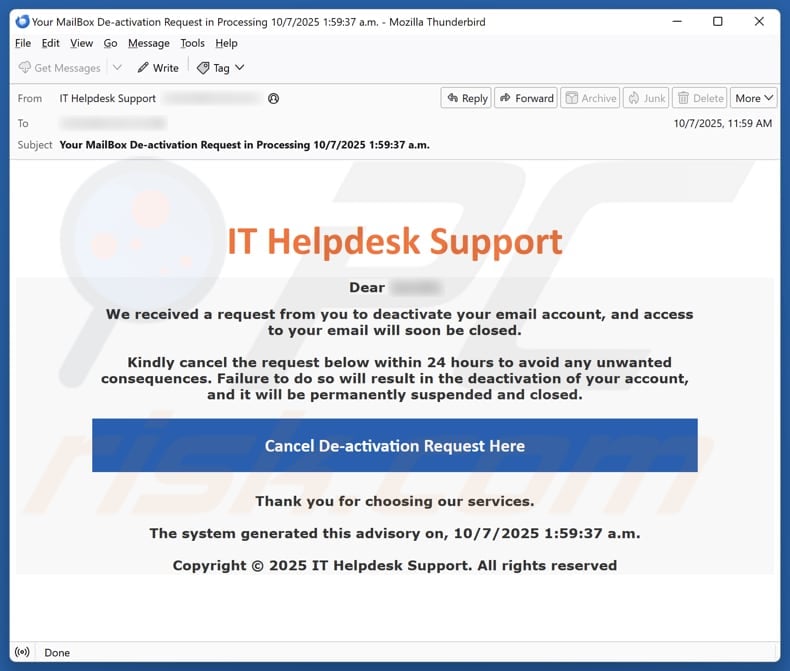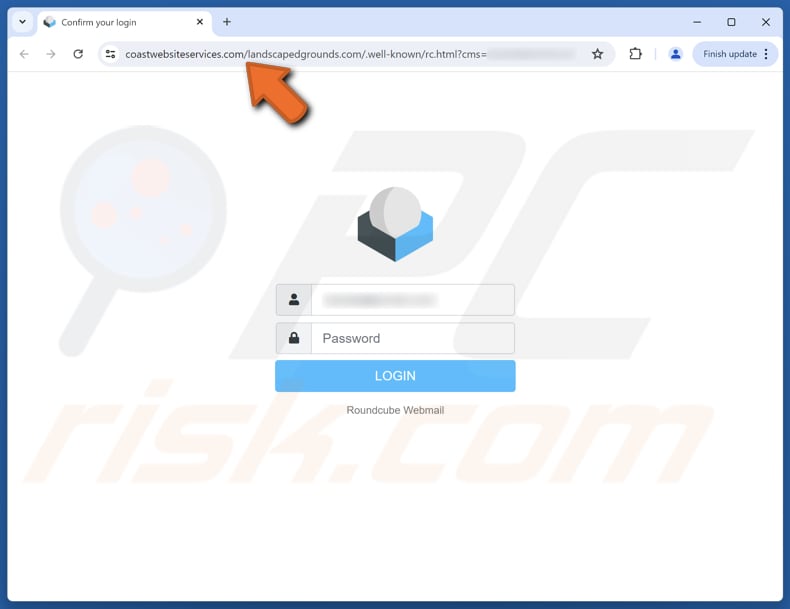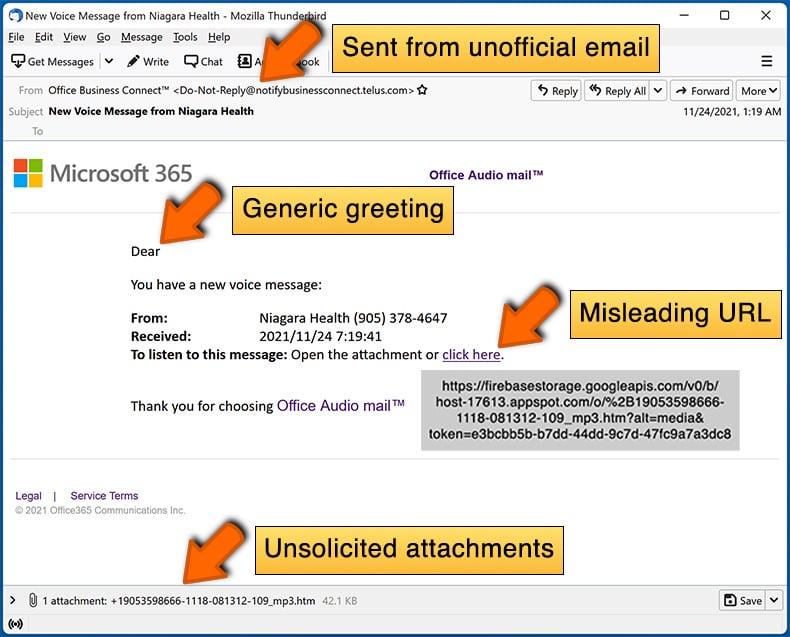How to recognize scams like "IT Helpdesk Support"
Phishing/ScamAlso Known As: IT Helpdesk Support phishing email
Get free scan and check if your device is infected.
Remove it nowTo use full-featured product, you have to purchase a license for Combo Cleaner. Seven days free trial available. Combo Cleaner is owned and operated by RCS LT, the parent company of PCRisk.com.
What kind of scam is "IT Helpdesk Support"?
We have examined the email and found that it contains a fake mailbox deactivation request. Its purpose is to trick unsuspecting recipients into clicking the provided link (opening a fake website) and entering personal information. Emails of this type are classified as phishing attempts.

More about the "IT Helpdesk Support" scam email
This phishing email states that a request to deactivate the recipient's email account has been received and that access to the account will soon be closed. It instructs the recipient to cancel the request within 24 hours to avoid negative consequences and warns that failure to do so will result in permanent suspension of the account.
The email includes a link ("Cancel De-activation Request Here") for canceling the deactivation request. Clicking this link opens a fake Roundcube Webmail login site designed to extract login credentials (email addresses and passwords) from visitors. Scammers can use this information for malicious purposes.
They can gain access to email, financial, gaming, or other online accounts. Once they have access, they may steal funds, make unauthorized purchases, impersonate the victim to send fraudulent messages or malware, collect sensitive documents and contacts, reset passwords on other services, and perform other malicious activities.
Stolen credentials can also be sold to other cybercriminals. For these reasons, it is crucial to be able to identify scam emails and avoid interacting with them to avoid any of the aforementioned consequences.
| Name | IT Helpdesk Support Email Scam |
| Threat Type | Phishing, Scam, Social Engineering, Fraud |
| Fake Claim | Recipient's email account will be closed |
| Disguise | Notification from "IT Helpdesk Support" |
| Related Domain | coastwebsiteservices[.]com |
| Detection Names (coastwebsiteservices[.]com) | CyRadar (Phishing), ESET (Phishing), Fortinet (Phishing), Seclookup (Malicious), Webroot (Malicious), Full List Of Detections (VirusTotal) |
| Symptoms | Unauthorized online purchases, changed online account passwords, identity theft, illegal access of the computer. |
| Distribution methods | Deceptive emails, rogue online pop-up ads, search engine poisoning techniques, misspelled domains. |
| Damage | Loss of sensitive private information, monetary loss, identity theft. |
| Malware Removal (Windows) |
To eliminate possible malware infections, scan your computer with legitimate antivirus software. Our security researchers recommend using Combo Cleaner. Download Combo CleanerTo use full-featured product, you have to purchase a license for Combo Cleaner. 7 days free trial available. Combo Cleaner is owned and operated by RCS LT, the parent company of PCRisk.com. |
Similar scam emails in general
Scams of this type are crafted to look urgent and credible in order to deceive recipients into sharing sensitive information (e.g., login credentials, financial details, or personal identification data). They often include links or attachments, and in some cases, such emails are also used to deliver malware.
A couple examples of similar scams are "DHL Package Is Ready For Delivery", "Join Google Meet", and "Migration To New Email Interface".
How do spam campaigns infect computers?
Threat actors often spread malware through email. The malware is usually hidden in infected attachments, such as Word or Excel files, PDFs, scripts, executable (.exe) files, or compressed files like ZIP or RAR archives. Opening malicious attachments or performing extra actions like enabling macros in documents can trigger the malware and infect your device.
Emails might also include links to fake or compromised websites. Visiting these sites can automatically download malware or trick you into downloading and running malicious software yourself.
How to avoid installation of malware?
Be wary of unexpected or irrelevant messages, especially from unknown senders. Do not open attachments or click on links in these messages. When browsing unfamiliar or risky websites, avoid clicking on ads, pop-ups, or any suspicious content. Always download software from reliable sources, such as official pages or app stores.
Do not grant notification permissions to untrusted websites. Keep your antivirus, operating system, and applications updated, and run regular security scans.
Text presented in the "IT Helpdesk Support" email letter:
Subject: Your MailBox De-activation Request in Processing 10/7/2025 1:59:37 a.m.
IT Helpdesk Support
Dear -
We received a request from you to deactivate your email account, and access to your email will soon be closed.Kindly cancel the request below within 24 hours to avoid any unwanted consequences. Failure to do so will result in the deactivation of your account, and it will be permanently suspended and closed.
Cancel De-activation Request Here
Thank you for choosing our services.
The system generated this advisory on, 10/7/2025 1:59:37 a.m.
Copyright © 2025 IT Helpdesk Support. All rights reserved
Fake website used in this scam:

Instant automatic malware removal:
Manual threat removal might be a lengthy and complicated process that requires advanced IT skills. Combo Cleaner is a professional automatic malware removal tool that is recommended to get rid of malware. Download it by clicking the button below:
DOWNLOAD Combo CleanerBy downloading any software listed on this website you agree to our Privacy Policy and Terms of Use. To use full-featured product, you have to purchase a license for Combo Cleaner. 7 days free trial available. Combo Cleaner is owned and operated by RCS LT, the parent company of PCRisk.com.
Quick menu:
- What is IT Helpdesk Support phishing email?
- Types of malicious emails.
- How to spot a malicious email?
- What to do if you fell for an email scam?
Types of malicious emails:
![]() Phishing Emails
Phishing Emails
Most commonly, cybercriminals use deceptive emails to trick Internet users into giving away their sensitive private information, for example, login information for various online services, email accounts, or online banking information.
Such attacks are called phishing. In a phishing attack, cybercriminals usually send an email message with some popular service logo (for example, Microsoft, DHL, Amazon, Netflix), create urgency (wrong shipping address, expired password, etc.), and place a link which they hope their potential victims will click on.
After clicking the link presented in such email message, victims are redirected to a fake website that looks identical or extremely similar to the original one. Victims are then asked to enter their password, credit card details, or some other information that gets stolen by cybercriminals.
![]() Emails with Malicious Attachments
Emails with Malicious Attachments
Another popular attack vector is email spam with malicious attachments that infect users' computers with malware. Malicious attachments usually carry trojans that are capable of stealing passwords, banking information, and other sensitive information.
In such attacks, cybercriminals' main goal is to trick their potential victims into opening an infected email attachment. To achieve this goal, email messages usually talk about recently received invoices, faxes, or voice messages.
If a potential victim falls for the lure and opens the attachment, their computers get infected, and cybercriminals can collect a lot of sensitive information.
While it's a more complicated method to steal personal information (spam filters and antivirus programs usually detect such attempts), if successful, cybercriminals can get a much wider array of data and can collect information for a long period of time.
![]() Sextortion Emails
Sextortion Emails
This is a type of phishing. In this case, users receive an email claiming that a cybercriminal could access the webcam of the potential victim and has a video recording of one's masturbation.
To get rid of the video, victims are asked to pay a ransom (usually using Bitcoin or another cryptocurrency). Nevertheless, all of these claims are false - users who receive such emails should ignore and delete them.
How to spot a malicious email?
While cyber criminals try to make their lure emails look trustworthy, here are some things that you should look for when trying to spot a phishing email:
- Check the sender's ("from") email address: Hover your mouse over the "from" address and check if it's legitimate. For example, if you received an email from Microsoft, be sure to check if the email address is @microsoft.com and not something suspicious like @m1crosoft.com, @microsfot.com, @account-security-noreply.com, etc.
- Check for generic greetings: If the greeting in the email is "Dear user", "Dear @youremail.com", "Dear valued customer", this should raise suspiciousness. Most commonly, companies call you by your name. Lack of this information could signal a phishing attempt.
- Check the links in the email: Hover your mouse over the link presented in the email, if the link that appears seems suspicious, don't click it. For example, if you received an email from Microsoft and the link in the email shows that it will go to firebasestorage.googleapis.com/v0... you shouldn't trust it. It's best not to click any links in the emails but to visit the company website that sent you the email in the first place.
- Don't blindly trust email attachments: Most commonly, legitimate companies will ask you to log in to their website and to view any documents there; if you received an email with an attachment, it's a good idea to scan it with an antivirus application. Infected email attachments are a common attack vector used by cybercriminals.
To minimise the risk of opening phishing and malicious emails we recommend using Combo Cleaner Antivirus for Windows.
Example of a spam email:

What to do if you fell for an email scam?
- If you clicked on a link in a phishing email and entered your password - be sure to change your password as soon as possible. Usually, cybercriminals collect stolen credentials and then sell them to other groups that use them for malicious purposes. If you change your password in a timely manner, there's a chance that criminals won't have enough time to do any damage.
- If you entered your credit card information - contact your bank as soon as possible and explain the situation. There's a good chance that you will need to cancel your compromised credit card and get a new one.
- If you see any signs of identity theft - you should immediately contact the Federal Trade Commission. This institution will collect information about your situation and create a personal recovery plan.
- If you opened a malicious attachment - your computer is probably infected, you should scan it with a reputable antivirus application. For this purpose, we recommend using Combo Cleaner Antivirus for Windows.
- Help other Internet users - report phishing emails to Anti-Phishing Working Group, FBI’s Internet Crime Complaint Center, National Fraud Information Center and U.S. Department of Justice.
Frequently Asked Questions (FAQ)
Why did I receive this email?
Fraudsters commonly gather email addresses from data breaches, fake websites, or similar sources. They typically send identical messages to large numbers of recipients instead of targeting someone in particular.
I have provided my personal information when tricked by this email, what should I do?
Immediately update all passwords if your login information has been shared. If any financial or identification data was compromised, notify the incident to local authorities (and your bank).
I have downloaded and opened a malicious file attached to an email, is my computer infected?
The computer may be infected, especially if the downloaded file is an executable (.exe). Malicious documents and other files usually require additional actions, such as enabling macros, to activate the malware.
I have read the email but did not open the attachment, is my computer infected?
Simply opening an email is safe. A system can become infected only if the recipient clicks on malicious links or opens infected attachments.
Will Combo Cleaner remove malware infections that were present in email attachment?
Combo Cleaner is capable of detecting and removing most known malware. Because sophisticated malware can be deeply integrated into the system, running a full system scan is highly recommended.
Share:

Tomas Meskauskas
Expert security researcher, professional malware analyst
I am passionate about computer security and technology. I have an experience of over 10 years working in various companies related to computer technical issue solving and Internet security. I have been working as an author and editor for pcrisk.com since 2010. Follow me on Twitter and LinkedIn to stay informed about the latest online security threats.
PCrisk security portal is brought by a company RCS LT.
Joined forces of security researchers help educate computer users about the latest online security threats. More information about the company RCS LT.
Our malware removal guides are free. However, if you want to support us you can send us a donation.
DonatePCrisk security portal is brought by a company RCS LT.
Joined forces of security researchers help educate computer users about the latest online security threats. More information about the company RCS LT.
Our malware removal guides are free. However, if you want to support us you can send us a donation.
Donate
▼ Show Discussion